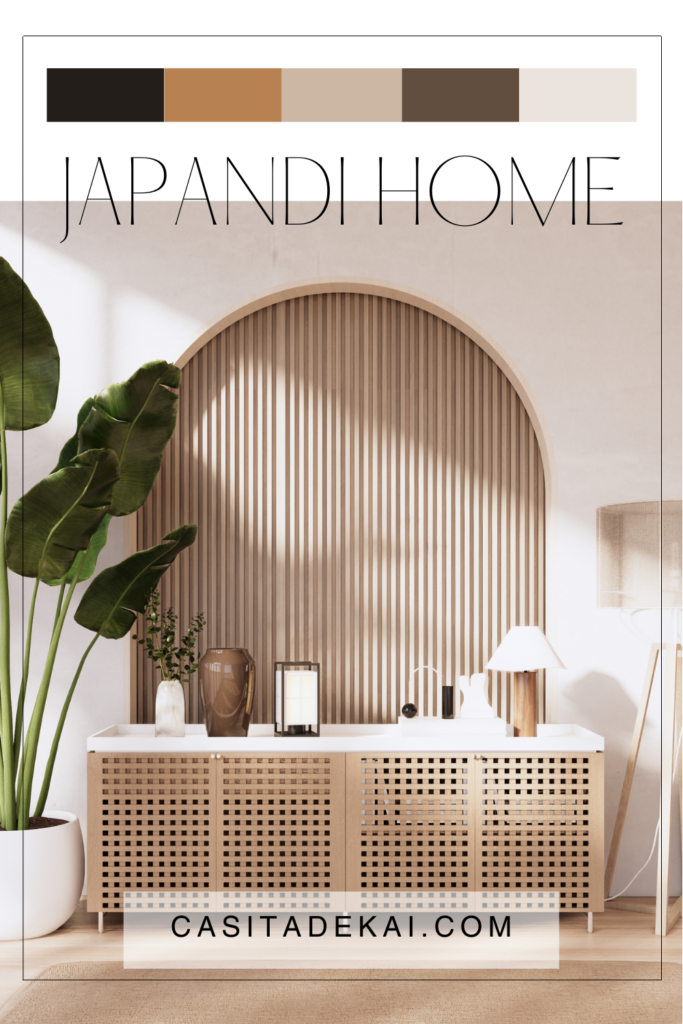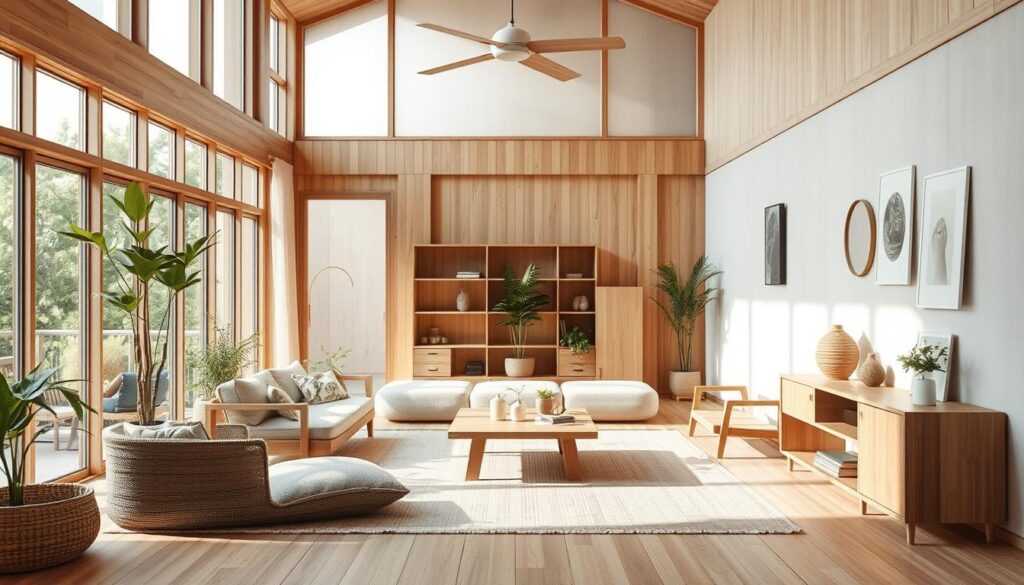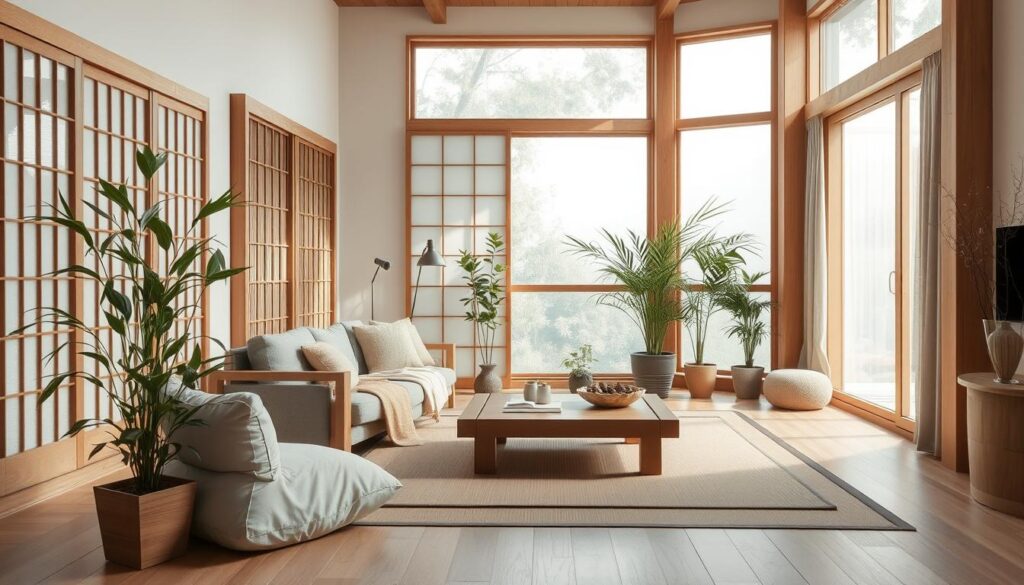
Walking into my home, I feel the warmth of natural wood and the calm of neutral tones. This mix of Japanese and Scandinavian styles has made my home a peaceful retreat. Japandi, the blend of these two styles, has turned my living space into a serene and stylish place.
In this article, we’ll dive into the world of Japandi home decor. We’ll see how to mix East and West to create a space that looks great and feels calm. We’ll explore the minimalist beauty of Scandinavian design and the detailed craftsmanship of Japanese style. Together, these elements make Japandi interiors truly special.
Key Takeaways
- Japandi interiors blend the minimalist aesthetics of Scandinavian design with the refined elegance of Japanese influences.
- Neutral color palettes, natural materials, and an emphasis on sustainability are hallmarks of the Japandi style.
- Japandi design celebrates the beauty of simplicity, with every item chosen for its purpose and functionality.
- Abundant natural light and the incorporation of greenery create a strong connection to nature in Japandi homes.
- Handcrafted decorative pieces and ceramics reflect the Japandi focus on craftsmanship and attention to detail.
What is Japandi Interior Design?
Japandi interior design combines Japanese and Scandinavian styles. It creates a calm and simple look. This mix brings together Japanese elegance and Scandinavian coziness, focusing on simplicity and natural elements.
Minimalism Meets Elegance
Japandi style values simplicity and natural materials. It uses muted colors and natural elements, aiming for a simple look. Even though Japandi furniture can be pricey, buying fewer, quality items makes it affordable.
Merging Japanese and Scandinavian Aesthetics
Japandi design blends clean lines with Scandinavian coziness and Japanese beauty. It combines minimalist Japanese design with Scandinavian warmth. Common materials include rattan, wood, and plants. Scandinavian designs also use velvet and leather.

Designers like Julee Wray and Mark Cravotta are key in Japandi design. This style started 150 years ago, when Scandinavian designers visited Japan.
Japandi design is all about sustainability. It values natural materials and craftsmanship over cheap, disposable items. It creates a cozy atmosphere with warm textures and a calm vibe
basq.livelarq.com
What is Japandi Interior Design?.
History of Japandi Style
The Japandi style has deep roots, dating back to when Japan opened up in the mid-1850s. Scandinavian designers were among the first to explore Japan, falling in love with its culture and design. They found a perfect blend of simplicity and quality in both Japanese and Scandinavian designs.
Japandi design mixes Scandinavian minimalism with Japanese simplicity. It’s inspired by Scandinavian hygge, which makes spaces cozy during cold winters. This mix has won hearts globally, with more people searching for Japandi style.
Centuries-Old Traditions Converge
The Japandi style has a rich history, blending Scandinavian and Japanese designs for over a century. It’s now loved worldwide, from the U.S. to Japan.
This blend of cultures has created a unique design movement. It combines Japanese simplicity with Scandinavian minimalism. This fusion offers a peaceful and practical way to live today.

Key Elements of Japandi Interiors
The Japandi interior design style focuses on four main elements: minimalism, natural light, neutral colors, and sustainability. It values simplicity, where every item serves a purpose. Large windows and white walls bring in natural light, linking indoors to outdoors.
Minimalism and Open Spaces
Japandi style is all about simplicity with clean lines and minimal decor. It aims for a calm space with less clutter. It combines Japanese ‘wabi-sabi’ and Scandinavian ‘hygge’ for a peaceful vibe.
Natural Light and Materials
Natural light is key in Japandi design, connecting us to nature. It uses materials like wood and stone for a natural feel. Sustainability is a big part, focusing on durable, natural materials.
Neutral Color Palettes
Japandi favors a calm color scheme for a zen effect. Shades like sage green and soft grey are common. It also uses beige, black, and white, along with earthy tones.
Japandi design combines Japanese and Scandinavian styles for a peaceful home.
Japandi Home Decor Ideas
Explore the beauty of East meets West with our Japandi home decor ideas. This mix of Scandinavian simplicity and Japanese elegance makes a peaceful, minimalist space. It highlights natural materials, calm colors, and organic shapes. Whether updating your living room, bedroom, or kitchen, these tips will help you create a stunning and soothing interior.
Begin with Japandi’s focus on minimalism and tidiness. Open up your rooms and let natural light in. Use mirrors to make spaces feel bigger. Choose durable, natural materials like wood, stone, and linen for furnishings. This shows Japandi’s love for sustainability and skillful craftsmanship.
Choose a soothing color scheme with beige, grey, and white to calm your space. Add greenery to bring in a natural touch, making your decor feel organic.
Appreciate the beauty of imperfection with wabi-sabi, valuing unique, handmade items. Add ceramic and glass accents for a touch of artisanal beauty.
Mix Scandinavian coziness with Japanese elegance for a minimalist haven that shows your style. Let these ideas guide you to a serene, timeless space that brings you peace and happiness.
Incorporate Wood Elements
Japandi design combines Japanese and Scandinavian styles, focusing on natural materials like wood. Wood adds a cozy feel, making spaces feel like they’re part of nature.
Designing a Japandi space means using wood in many ways. Think wooden furniture, floors, and walls. The wood’s natural look and feel enhance the minimalist style, making it warm and peaceful.
For a classic Japandi vibe, oak or walnut wood is great. They add depth and authenticity to your living room. Adding Japanese touches like shoji screens and tatami mats brings cultural richness.
Pairing wood with Scandinavian design, like mid-century modern chairs, creates a perfect mix. Clean lines and shapes make the space feel organized and streamlined.
Wood is key in Japandi design, bringing warmth and coziness to any room. By using wood, you create a Japandi home that’s serene and balanced.
Embrace Negative Space
Japandi interiors focus on empty space, making each piece stand out. This creates a calm and open feel. It’s a mix of Japanese minimalism and Scandinavian simplicity. Negative space is key to this blend.
Decluttering for Serenity
Keeping the space clean is vital for Japandi’s calm vibe. It uses negative spaces for a clutter-free feel. This “less is more” idea helps create a peaceful place for relaxation.
Japandi design is all about openness and freedom. It also uses eco-friendly materials. This thoughtful design boosts both looks and calmness, benefiting our minds and souls.
Celebrate Wabi-Sabi Beauty
In Japandi design, wabi-sabi is a key part. It loves the beauty of imperfection and simplicity. This art celebrates the natural look of materials, letting their unique qualities show. As Japandi blends Japanese and Scandinavian styles, wabi-sabi’s charm is seen more in homes.
To bring wabi-sabi into your space, mix rustic and simple items. Use raw or worn finishes and accept the space’s imperfections. Wabi-sabi loves organic shapes and uneven decor, just like nature. Let your furniture and decor show their age, seeing the wear as a natural part of their story.
Wabi-sabi helps make a calm and peaceful place. Choose earthy colors and textures that remind you of nature. Add handmade items and crafts to make your space personal and unique.
Let your Japandi space grow and change like nature does. This design way shows the true spirit of wabi-sabi. It also brings a real and connected feel to your home.
Organic Furniture Shapes
In the world of Japandi interior design, we see a mix of Japanese and Scandinavian styles. Here, organic furniture shapes are key. These pieces, made with clean lines and natural materials, show the beauty of minimalism and timeless design.
Japandi interiors don’t have big, casual sofas like other styles. Instead, they feature minimalist furniture that looks elegant. Made from wood, bamboo, and rattan, these pieces show the skill of centuries-old craftsmanship.
The organic shapes of Japandi furniture add to the calm and harmony of this design. Clean lines and natural forms make a visual balance. This balance brings peace and balance to the space.
Japandi design loves the simplicity and elegance of natural materials. These furniture shapes, with their subtle beauty, mix East and West traditions. They create a peaceful and beautiful living space.
Bring in Greenery
Japandi design loves nature. It celebrates the beauty of the outdoors. Adding greenery is key to this look. It could be a lush plant, a simple branch, or dried flowers. These natural touches bring life and calm to Japandi spaces.
Greenery makes a big difference in Japandi spaces. People look for big plants to make their homes peaceful. Plants like the Kentia palm or the fiddle-leaf fig mix Japanese and Scandinavian styles well.
Japandi isn’t just about plants. Ideas like kokedama or nature-inspired decor add outdoor vibes to homes. It’s about choosing a few big plants for a calm feel.
Greenery in Japandi design shows love for nature. It brings a refreshing feel to homes. This makes Japandi a timeless and popular choice.
| Japandi Design Elements | Description |
|---|---|
| Natural Materials | Japandi design loves wood, rattan, cane, and bamboo. It shows a deep respect for nature’s beauty. |
| Neutral Color Palettes | Japandi spaces use calm, natural colors. This creates a peaceful and balanced feel. |
| Minimalist Aesthetics | Japandi focuses on simplicity and function. It lets natural beauty stand out. |
| Greenery | Plants and flowers are key in Japandi design. They connect indoor spaces to the outdoors. |
Paper Lantern Lighting
Paper lanterns are a key part of Japanese decor and fit well in Japandi style. Designers have made modern versions of these lanterns. They mix old and new beautifully.
Paper lanterns add a soft glow to Japandi homes. They come in many forms, like table lamps and pendant lights. These lights make spaces feel warm and welcoming.
More and more people are looking for Japandi wall lights. This shows the growing interest in modern paper lanterns.
Paper lanterns can hang from the ceiling or sit on a table. They mix Japanese style with modern lighting. Options like the Hashira Collection and Beige Ceramic Wabi Sabi Wall Sconce add elegance to any room.
Using paper lantern lighting brings Japandi design to life. It’s all about simplicity, calmness, and natural beauty. As this trend grows, we’ll see even more creative uses of paper lanterns.
Contrast with Dark Accents
Japandi design often features soft, airy colors. But, dark tones are key to balance and depth. Colors like black and muted blue highlight furniture and walls, creating a striking contrast. This contrast makes the light and simple Japandi style more meaningful.
The ratio of accent colors used in Japandi design is carefully planned. Black, muted blues, and pastel pinks are used sparingly, each making up 1/10 of the color scheme. This adds visual interest and grounds the space, creating balance and depth.
The occurrence rate of wooden elements in Japandi decor is also significant. Natural wood furniture makes up 1/3 of the decor. This blend of wood and dark accents harmonizes light and dark, merging Japanese and Scandinavian styles.
Dark accents in Japandi design go beyond furniture and decor. Recommended colors include Gray Cloud 2126-60 by Benjamin Moore and Moonlight by Backdrop. These colors help achieve balance, depth, and contrast, key to the Japandi look.
In summary, dark accents are vital in Japandi design, adding richness and balance. By using these contrasting tones, we can create a stunning Japandi space that blends East and West beautifully.
Handcrafted Ceramics and Decor
In Japandi interior design, handmade ceramics are key, showing off craftsmanship and love for nature. These ceramics, with their unique flaws, vintage charm, and striking designs, add depth and character. They celebrate the beauty of imperfection, fitting perfectly with Japandi’s wabi-sabi philosophy.
Japandi loves unique items like glass vases and ceramic bowls, making them focal points. Handmade accessories, like woven baskets and ceramics, highlight tradition and add warmth. Earthy planters bring the outdoors in, making the space feel more harmonious.
| Handcrafted Ceramics in Japandi Design | Natural Materials | Imperfections | Craftsmanship |
|---|---|---|---|
| Unique pottery with subtle imperfections | Light-toned wood like oak, beech, or pine | Charming patina of vintage objects | Handwoven baskets and artisanal ceramics |
| Striking vases or textured bowls | Ceramic, stone, wicker, and bamboo | Rough and irregular surfaces like marble or wood | Custom joinery and seamless cabinetry |
Japandi design loves the beauty in imperfections, celebrating the natural look of handmade items. These unique pieces not only catch the eye but also show Japandi’s wabi-sabi values.
“Japandi style embraces unique handcrafted objects like glass vases and ceramic bowls, which serve as focal points and harmonize with the minimalist principles of the design.”
Conclusion
Japandi home decor is a mix of Japanese and Scandinavian styles. It makes our homes calm and minimalist interiors that love natural materials and the outdoors. Adding wood, empty space, and unique beauty, our homes become peaceful places.
The core of japandi home decor is sustainable design. It values simplicity, love for nature, comfort, and being useful. With neutral colors, handmade items, and natural materials like wood and stone, Japandi teaches us to live in harmony with nature.
By bringing Japandi into our homes, we get a calm and refreshing living space. The lines between inside and outside fade, and we’re surrounded by elegance. Japandi helps us create spaces that soothe our senses, encourage mindfulness, and inspire a more mindful life.
FAQ
What is Japandi interior design?
Japandi interior design combines Japanese and Scandinavian styles. It creates a minimalist, cozy, and stylish space. This blend brings together Japanese elegance and Scandinavian warmth.
What are the key elements of Japandi interiors?
Japandi interiors focus on minimalism, natural light, and neutral colors. They also value sustainability. The goal is to keep things simple, use quality materials, and connect with nature.
How can I incorporate wood elements in a Japandi-inspired home?
Wood is key in Japandi decor, adding warmth and softness. Use wooden furniture, floors, and walls to make your space cozy. This blends indoor and outdoor spaces beautifully.
What is the role of negative space in Japandi design?
Japandi design emphasizes empty space. This lets chosen pieces stand out, creating openness and calm. Keeping the space clean and clutter-free is essential.
How can I celebrate the wabi-sabi aesthetic in my Japandi home?
Wabi-sabi celebrates simplicity and imperfection. Mix rustic and minimalist pieces for a unique look. Embrace the space’s natural imperfections for authenticity.
What role do plants and greenery play in Japandi design?
Plants add life to Japandi homes. They bring vitality to minimalist spaces. Using plants and natural elements connects you to nature.
How can I use paper lanterns in a Japandi-inspired space?
Paper lanterns fit well in Japandi design. They offer a modern twist on traditional Japanese decor. This blend of old and new adds interest.
What role do dark accents play in Japandi design?
Dark accents add balance and depth to Japandi spaces. They contrast with light colors, making the space visually appealing. Dark tones highlight furniture and walls.
How can I incorporate handcrafted ceramics in my Japandi home?
Handcrafted ceramics are vital in Japandi design. They show appreciation for natural materials and craftsmanship. Unique ceramics add character and beauty to your space.